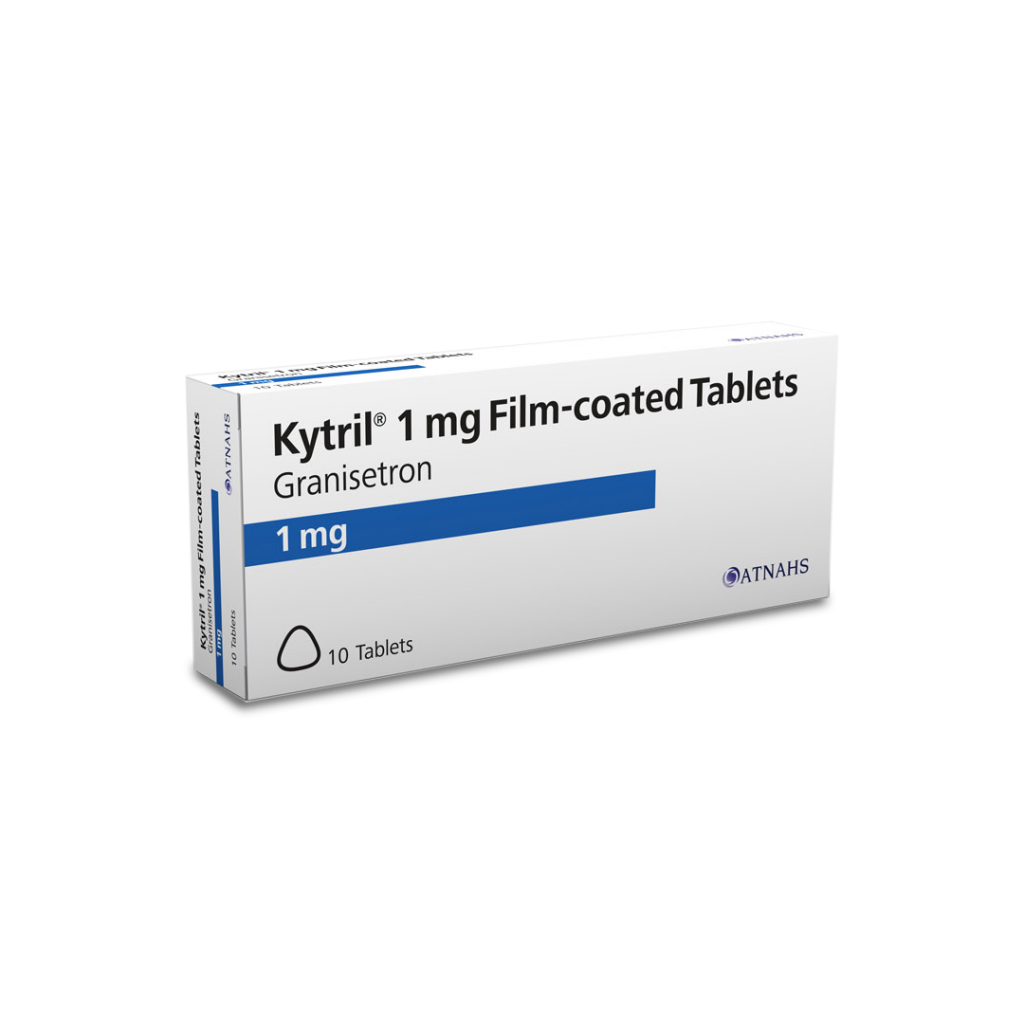This website uses cookies so that we can provide you with the best user experience possible. Cookie information is stored in your browser and performs functions such as recognising you when you return to our website and helping our team to understand which sections of the website you find most interesting and useful.
Kytril
Brand Name :
Kytril
Generic Name :
Granisetron
Partner :
Atnahs

Download
Kytril Leaflet

What is this drug and what is it used for?
Indications and potential uses
Cytostatic chemotherapy
In adults for the prevention (oral, intravenous) and treatment (intravenous) of nausea and vomiting induced by cytostatic chemotherapy.
In children aged 2 years and above for the prevention (intravenous) and treatment (intravenous) of nausea and vomiting induced by cytostatic chemotherapy.
Radiotherapy
In adults for the prevention (oral, intravenous) and treatment (intravenous) of nausea and vomiting induced by radiotherapy.
Postoperative nausea and vomiting
In adults for the treatment (intravenous) of postoperative nausea and vomiting.
How is this drug given?
One 1 mg Kytril film-coated tablet twice daily or one 2 mg tablet once daily during and for up to a week after cytostatic therapy.The first dose of Kytril should be taken within one hour before the start of cytostatic therapy.
Patients weighing over 50 kg: One ampoule (granisetron 3 mg/3 ml) is diluted in 20–50 ml infusion solution and administered over 5 minutes before cytostatic therapy. This 3 mg dose ampoule can also be given as a bolus injection over 30 seconds.
Patients weighing under 50 kg: 20–40 μg/kg body weight; the appropriate volume of Kytril solution should preferably be diluted in 20–50 ml infusion solution and administered over 5 minutes before cytostatic therapy. Alternatively, the appropriate volume of Kytril solution can also be given as a bolus injection over 30 seconds. Ampoules containing 3 mg/3ml and 1 mg/1 ml are available for this purpose. The infusion should be completed before cytostatic therapy is started.
In clinical trials the majority of patients have required only a single dose to control nausea and vomiting over 24 hours.
Cytostatic chemotherapy (treatment) Intravenous:
Breakthrough nausea and vomiting may occur in a small number of patients. If necessary, up to two additional 5-minute infusions of no more than 3 mg, given at least 10 minutes apart, may be administered within 24 hours. The maximum dose is 9 mg/24 hours.
Radiotherapy (prevention) Oral:
should be administered within one hour before the start of radiotherapy.
Intravenous:
The same dosage recommendations apply as for the indication Cytostatic chemotherapy (prevention).
Radiotherapy (treatment)
Intravenous:
Breakthrough nausea and vomiting may occur in a small number of patients. If necessary, up to two additional 5-minute infusions of no more than 3 mg, given at least 10 minutes apart, may be administered within 24 hours. The maximum dose is 9 mg/24 hours.
Radiotherapy (prevention)
Oral:
One 2 mg film-coated tablet once daily. The first dose should be administered within one hour before the start of radiotherapy.
Intravenous:
The same dosage recommendations apply as for the indication Cytostatic chemotherapy (prevention).
Radiotherapy (treatment)
Intravenous:
Breakthrough nausea and vomiting may occur in a small number of patients. If necessary, up to two additional 5-minute infusions of no more than 3 mg, given at least 10 minutes apart, may be administered within 24 hours. The maximum dose is 9 mg/24 hours.
Postoperative nausea and vomiting (treatment)
Intravenous:
For the treatment of postoperative nausea and vomiting, a single dose of 1 mg of Kytril should be administered by slow intravenous
injection (over 30 seconds).
Experience exists with intravenous Kytril doses of up to 3 mg in patients undergoing elective surgery under anesthesia.
Special dosage instructions
Children
Cytostatic therapy (prevention)
Intravenous: A single dose of 20 µg/kg body weight, diluted in 10–30 ml infusion solution, should be administered by intravenous infusion 5 minutes before cytostatic therapy.
Cytostatic therapy (treatment)
Intravenous:
Up to two additional 5-minute infusions of 20 µg/kg body weight, given at least 10 minutes apart, may be administered.
The maximum dose is 3 times 20 µg/kg per 24-hour period.
Postoperative nausea and vomiting
No experience is available on the use of i.v. or oral Kytril to prevent or treat postoperative nausea and vomiting in children.
Geriatrics, liver failure, renal failure:
No dosage adjustment required (see “Dosage and administration, Standard dosage in adults”).
Possible side effects
In most cases, the adverse events seen in association with Kytril have not been severe and have been tolerated by patients, so that treatment has not had to be stopped.
The most frequently observed adverse reactions with Kytril were headache and constipation, which may be transient. ECG changes including QT prolongation have also been observed with Kytril.
The following adverse reactions, based on clinical studies and post-marketing experience, have been observed in association with Kytril:
Very common (≥1/10), common (>1/100 to <1/10), uncommon (>1/1000 to <1/100), rare (>1/10,000 to <1/1000) and very rare (<1/10,000).
Immune system
Uncommon: hypersensitivity reactions (which have sometimes been severe, e.g. anaphylaxis).
Nervous system
Very common: headache (14%).
Heart
Uncommon: QT prolongation.
Isolated serious adverse events (hypotension, cardiac arrhythmias) have been reported. Cases of ECG changes, including QT prolongation, have occurred (see “warnings and precautions”).
Gastrointestinal disorders
Very common: constipation.
Hepatobiliary system
Common: transaminase elevation (same frequency as with placebo).
Skin
Uncommon: rash, edema/facial edema.
General disorders
Uncommon: flu-like symptoms including fever and chills.












